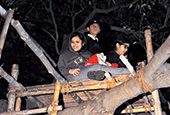 |
| The machaan was the ‘high’light for the green gang that trailed through Rabindra Sarobar on Thursday night |
A group of around 15 enthusiasts, flashlights in hand, hugged tight their hooded jackets and huddled deep into Rabindra Sarobar on the night of Thursday the 12th.
The chill was only beaten by the thrill. For these were Calcutta’s “first nocturnal nature walkers” at the Lakes.
Each member trod carefully along the banks of the water body, careful not to step on the slippery algae as they paused at intervals to peer into the waters.
“Look! That’s a snakehead. They are an aggressive species that can drive away any fish of its size,” said Nilanjan Mukherjee, an English student at Jadavpur University by day and a fish and reptile expert by night. He pointed his torch at a two-foot-long striped fish, glistening in the moonlight. Everyone leaned forward, some clicked pictures while others also spotted the rui maachh and tilapia as they swum in schools nearby.
Further down, the group stopped to look at “nature’s signs” — bird droppings on the road, an indication of a roosting place above, or the skull of a crow.
 |
 |
 |
| Some of the nocturnal finds of the nature walk were (from top) stink bugs, a dead moth and slug. (Anindya Shankar Ray) |
“Few know that the 193-acre area is home to parrots, barbets, starlings, mynah and harder-to-spot birds like Golden Oriole and Red-throated Flycatcher. There are around 128-132 species of butterflies in Calcutta and almost 70-80 of these can be found in Rabindra Sarobar,” said Arjan Basu Roy, nature guide for the night, and founder of green NGO Nature Mates-Nature Club.
The expert’s idea of coming close to nature is getting down (and often dirty). “Unless you are there, you don’t know what to protect. Unless you see the fish, study the trees, enjoy the silence of the night and the moonlit sky, the urge to protect and love nature will not come from within. You can say ‘I won’t cut trees’ but only when surrounded by nature can you really begin to mean those words,” said Arjan.
The green gang let nature take its course, stopping next at a tree, home to many slimy slugs, snail-like creatures without the shell. An adventurous Ishika Mukherjee, 21, reached out her hand to hold a slug. “It’s the first time I held a slug in my hand and weird as it sounds, it was so exciting! It left a shiny trail on my palm, which I wiped off with a leaf later. It’s so strange because I live close by and I used to come here for my morning walks but I’ve never noticed these things before,” said the student of ISB&M College, visibly awed at her first real brush with nature.
It is this awe that Mudar Patherya feels will bring nature lovers like Ishika to the Rabindra Sarobar. “A sense of awe is what needs to be created. We need to identify the champions of the wild — be it a 60ft radius of a Shirish rain tree, or a simple slug — so that people talk of the Rabindra Sarobar as an amazing natural habitat. And the best thing is you don’t have to go to a forest: a sanctuary packed with wildlife is near your home,” said the green activist who conceptualised the walk on the wild side.
As the group moved deeper into the dark, their paths lit only by the light from their cellphones and a few torches, it got more exciting with spiders, stink bugs and fruit bats. One tree had a machaan (a tree house without a roof) built especially for bird watchers. Sneha Paul, 21, was one of the first to climb the bamboo ladder to the top of the foliage. “I could see the nests of birds and the vastness of the lake ahead. Cool breeze on your face, the silence of the night broken occasionally by the sound of crickets… it was beautiful. I hope they build more of these machaans. I would love to go for nature walks every week.”
If plans work out, the hotel management (NSHM) student may be able to that. Both day and night trails are on the cards, with the next one scheduled for the first week of February.
“These trails are not just for nature lovers but also for those who want field-oriented practical knowledge to pursue it as a career with wildlife NGOs later,” said Arjan, adding, “Other plans include a flower haat on Saturday or a vegetable market on Sunday. We will also build two-three more machaans.”
The Rabindra Sarobar authorities have long wanted to alter the kind of footfall that comes into the area. “We want to make this place a hub for all kinds of nature activities. This first-of-its-kind nature trail created quite a buzz and we want to make the place more accessible to the public, especially nature lovers, sportspersons and youngsters. There are very few cities in India that have waterbodies like ours,” said Vivek Bharadwaj, the CEO of CMDA.
Do you want to hit the nature trail at night? Tell ttmetro@abpmail.com











